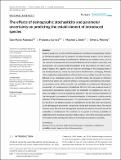| dc.contributor.author | Palamara, Gian Marco | |
| dc.contributor.author | Carrara, Francesco | |
| dc.contributor.author | Smith, Matthew J. | |
| dc.contributor.author | Petchey, Owen L. | |
| dc.date.accessioned | 2017-06-16T13:34:14Z | |
| dc.date.available | 2017-06-16T13:34:14Z | |
| dc.date.issued | 2016-10 | |
| dc.date.submitted | 2016-08 | |
| dc.identifier.issn | 2045-7758 | |
| dc.identifier.uri | http://hdl.handle.net/1721.1/109932 | |
| dc.description.abstract | Invasive species are a serious threat to biodiversity worldwide and predicting whether an introduced species will first establish and then become invasive can be useful to preserve ecosystem services. Establishment is influenced by multiple factors, such as the interactions between the introduced individuals and the resident community, and demographic and environmental stochasticity. Field observations are often incomplete or biased. This, together with an imperfect knowledge of the ecological traits of the introduced species, makes the prediction of establishment challenging. Methods that consider the combined effects of these factors on our ability to predict the establishment of an introduced species are currently lacking. We develop an inference framework to assess the combined effects of demographic stochasticity and parameter uncertainty on our ability to predict the probability of establishment following the introduction of a small number of individuals. We find that even moderate levels of demographic stochasticity influence both the probability of establishment, and, crucially, our ability to correctly predict that probability. We also find that estimation of the demographic parameters of an introduced species is fundamental to obtain precise estimates of the interaction parameters. For typical values of demographic stochasticity, the drop in our ability to predict an establishment can be 30% when having priors on the demographic parameters compared to having their accurate values. The results from our study illustrate how demographic stochasticity may bias the prediction of the probability of establishment. Our method can be applied to estimate probability of establishment of introduced species in field scenarios, where time series data and prior information on the demographic traits of the introduced species are available. | en_US |
| dc.description.sponsorship | Swiss National Science Foundation (Early Postdoc.Mobility Fellowship) | en_US |
| dc.language.iso | en_US | |
| dc.publisher | Wiley Blackwell | en_US |
| dc.relation.isversionof | http://dx.doi.org/10.1002/ece3.2495 | en_US |
| dc.rights | Creative Commons Attribution 4.0 International License | en_US |
| dc.rights.uri | http://creativecommons.org/licenses/by/4.0/ | en_US |
| dc.source | Wiley | en_US |
| dc.title | The effects of demographic stochasticity and parameter uncertainty on predicting the establishment of introduced species | en_US |
| dc.type | Article | en_US |
| dc.identifier.citation | Palamara, Gian Marco et al. “The Effects of Demographic Stochasticity and Parameter Uncertainty on Predicting the Establishment of Introduced Species.” Ecology and Evolution 6.23 (2016): 8440–8451. | en_US |
| dc.contributor.department | Massachusetts Institute of Technology. Department of Civil and Environmental Engineering | en_US |
| dc.contributor.mitauthor | Carrara, Francesco | |
| dc.relation.journal | Ecology and Evolution | en_US |
| dc.eprint.version | Final published version | en_US |
| dc.type.uri | http://purl.org/eprint/type/JournalArticle | en_US |
| eprint.status | http://purl.org/eprint/status/PeerReviewed | en_US |
| dspace.orderedauthors | Palamara, Gian Marco; Carrara, Francesco; Smith, Matthew J.; Petchey, Owen L. | en_US |
| dspace.embargo.terms | N | en_US |
| dc.identifier.orcid | https://orcid.org/0000-0003-2827-5615 | |
| mit.license | PUBLISHER_CC | en_US |
| mit.metadata.status | Complete | |
